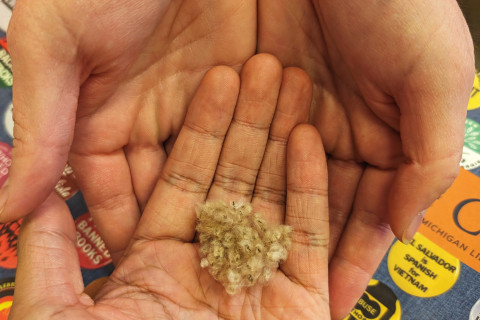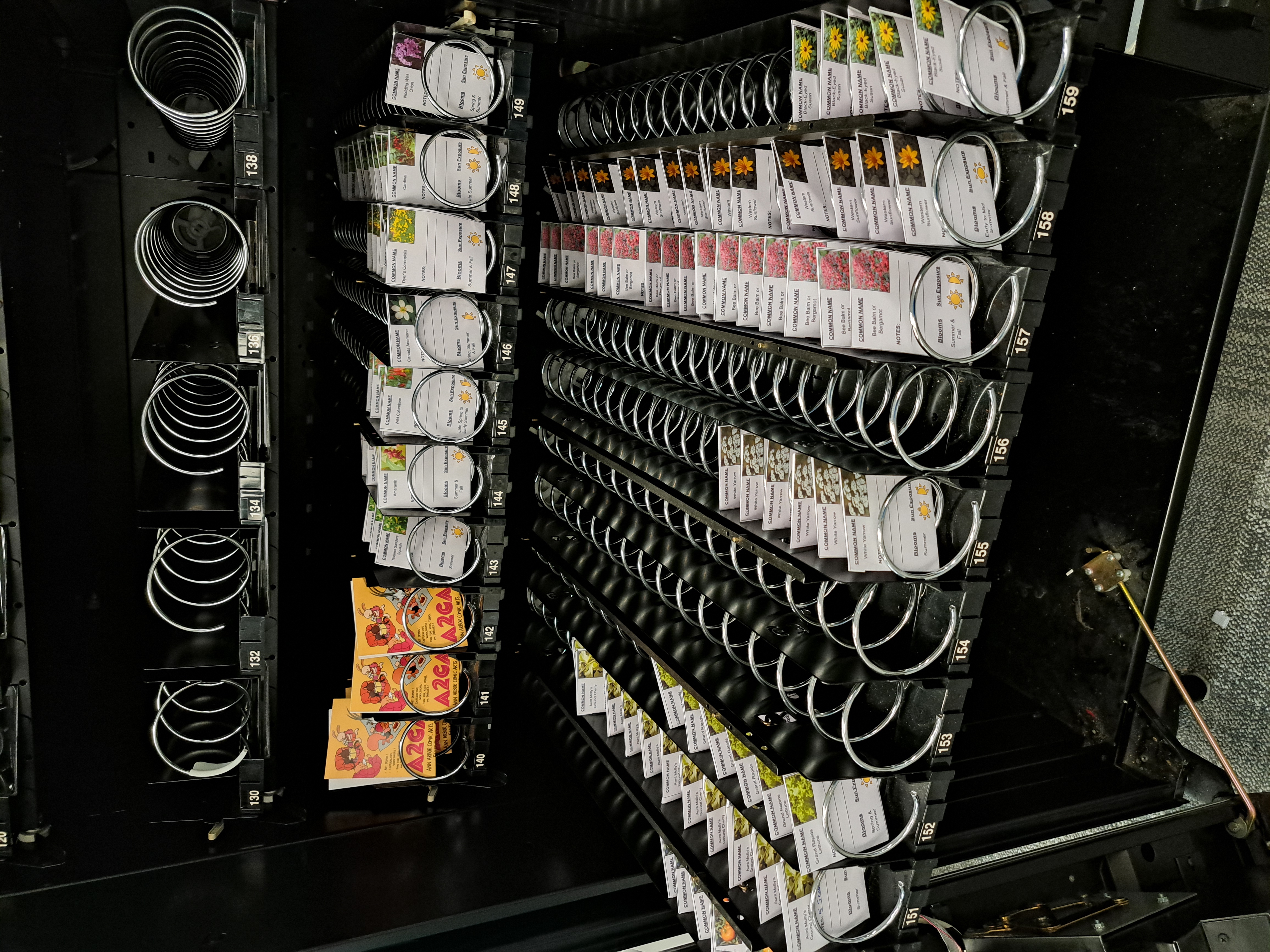Working as a Seed Library Engagement Fellow has been one of the biggest highlights of my time here at UMSI! Through this role, I’ve been able to get hands-on experience in program management, developed a better understanding of how interlibrary communication and collaboration works, and gained a new appreciation for the wonderful world of seeds!
The Seed Library recently celebrated its first anniversary having officially launched with a kickoff event on April 22, 2024. The Seed Library offers free seed packets of native Michigan wildflower and local garden vegetable seeds. Community members are encouraged to check out seeds, grow their harvest, and return some seeds to help keep the cycle going.

Seeds and their respective harvests are a community resource
Thanks to a collaboration with the wonderful Design Lab team, the Seed Library currently resides in the Design-O-Matic, located in the PIE Space on the first floor of the Shapiro Library. Our goals have been (and continue to be) to grow seed knowledge and encourage community engagement through hands-on experiences, accessible digital and physical content, and providing a space for collaboration and learning.

The Design-O-Matic, a vending machine that houses materials to create personal projects, currently provides free seeds. It is located at the back of 1st floor of the Shapiro Library in the PIE space
This process has involved many moving pieces. We had to figure out what seeds to include in the first collection, decide where the library would live on campus, and figure out the best ways to share information about this emerging program. One of my favorite parts of this experience has been researching local seed varieties and understanding seed growing conditions. Prior to my time with this program, I had very little knowledge about plants, but now I’ve learned so much about the quirks of different varieties and new terminology in gardening and seed topics. I am definitely not a pro yet, but I feel more confident in my ability to start a home garden this spring! We have also been fostering connections across the Ann Arbor, Flint, and Dearborn campuses, as well as partnered with some amazing local and campus community groups. Some of whom have provided invaluable knowledge and enthusiastic support throughout, such as Seeds to Community, the Campus Farm, and East Quad Gardens.
Much like our seeds, the program’s focus has shifted to growth after putting down our roots during our first year of experience. This has looked like revamping our original packaging to simpler and more targeted visuals and creating a more streamlined process through the creation of a Google site as a central information base. The site includes growing information for individual seeds, definitions of common gardening terms, and links to library resources. You can check the site out here: U-M Library: Seed Library!
Creating the site was a fun challenge. It wasn’t just about figuring out what content should be included, but it was also about how to arrange this information in a way that was organized and accessible. We have been working closely with the Library’s Digital Accessibility Team, especially Ben Howell, whose input has been incredibly helpful in making the site accessible, easy to navigate, and visually pleasing. The process gave me the opportunity to apply class concepts to a real-world scenario while also thinking critically about user experiences and working through inclusive design challenges along the way. We also consulted with Heidi Burkhardt, the Library’s Web Project Manager and Content Strategist, to decide on the best format for presenting our materials. Most digital seed library information follows a traditional research guide format, and while we considered this approach, we ultimately wanted an option that allowed for flexibility in detailed growing information. This flexibility will also aid our next step regarding creating room for future community-contributed content such as incorporating community seed stories.
One of the biggest challenges was arranging information in a way that was both concise and informative. Different layout options affected the flow of information and we wanted to ensure that the site was structured following accessibility guidelines, without losing important details. We also had to be mindful of copyright when choosing and uploading images, so we were intentional about using openly licensed images with appropriate attributes. This parallels the considerations we had at the beginning of the project, seeds themselves are subject to legal restrictions, usage rights, and stewardship considerations. Recognizing these complexities helped inform how we approached the digital and physical components of the Seed Library.
The balance between internal planning and community-facing work has been a new experience for me. Most of my prior project experiences started after the initial planning phase, so having the opportunity to be involved from the early stages has been a really eye-opening experience. We’ve documented our goals and progress, while ensuring to create experiences and materials that are community-focused. As of now, the Seed Library has established roots on campus and an estimated 800+ seed packets checked out by the community. We’ve also been working toward a new packaging structure that connects the physical and digital elements of the program. Images on the seed packets match those on the site, and each packet includes a QR code that links directly to the corresponding online information. We are also continuing to grow our digital presence and plan to keep adding new varieties and updates based on feedback from users.
I have really enjoyed the last two years as a Library Engagement Fellow, it’s been so valuable for learning how to support and actively grow a program within a library. I’m especially thankful for all the support I have received from Caylen, who has been an amazing mentor throughout this process. Caylen has always kept communication open and made sure I felt like a true member of the team. I have gotten to take on unexpected challenges like digging into seed law, exploring seed library case studies, and researching seed-saving practices which have all influenced my approaches to assisting in building the program, and will undoubtedly aid my professional growth for years to come.
There’s so much I have learned and so much more still to learn. I am so proud of everything that has been accomplished so far and I am excited to see how the Seed Library continues to grow!